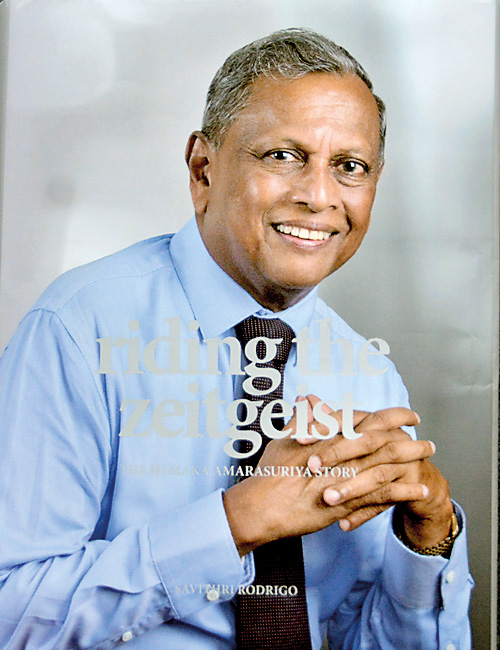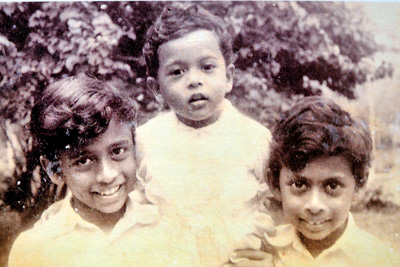Hemaka’s story: Life and times of another top corporate giant
View(s):Hot on the heels of the story of corporate leader – Ken Balendra, released late last year, the Hemaka Amarasuriya’s biography titled “Riding the Zeitgeist” takes the reader through the passages of time as each page unravels another time, space and era.

Book cover
Written by media personality Savithri Rodrio, who also wrote Mr. Balendra’s biography on the life and times of the retired, iconic chairman of John Keells Holdings, the story of Hemaka Amarasuriya is somewhat, slightly different in the sense it shares many pages of the life and times of Thomas Amarasuriya, Hemaka’s father, a Ceylonese planter and politician who ended up as President of the Senate, the upper chamber of the Parliament of Ceylon, in 1963.
The story of Hemaka is about a young boy who enjoyed life to the fullest, days playing with his friends – be it cricket or rugger – in the nearby grounds – Havelock Park, BRC and Colts – or in large, spacious gardens, which was how most homes were made up of, getting into mischief and naughty happenings – those days, these were done in good fun and without any malice.
This is also a story of a young man who joined multinational Singer as an accountant and transformed it from a worldwide sewing machine brand to a company producing and marketing a wide range of consumer durables like washing machines and refrigerators, etc.
His love for music took him to many concerts with favourites being the Backstreet Boys and locally, the Lanerolle Brothers, whose concerts he never missed to the point of rescheduling an overseas trip to be present.
Hemaka’s first job was at Turquand Young as an articled clerk but how he got it was very interesting. The then 22-year old was accompanied by his parents, mother Lucille and father Thomas (Amarasuriya) mainly because they were not sure whether he would change his mind or not.
While being interviewed, Senior Partner of Turquand Young (now Ernst & Young) M.T.L. Fernando, looked at him and said: “He is 22. We usually take only school leavers or graduates.”
“Being neither, Hemaka envisioned his hopes of working in accountancy dashed as well. But Fernando’s reasoning was not good enough for the feisty Lucille. Using her most persuasive skills, she convinced the Senior Partner to take her son and give him a chance,” the book says, much of it which comes alive with life during the carefree times of the 1960s to the 1980s.
Excerpts from the book: On Singer days:
“Joining Singer Sri Lanka as an accountant in 1973 and as the years flew pass, he decided it was time for a paradigm shift in the brand. Thus came the focus on constructing a brand that incorporated manifold dynamics, spearheaded by a team that was remodeled to suit his vision. He wasn’t disappointed. Both Amarasuriya and the brand proved their mettle, embarking on a meteoric rise, living by his brand mantra.”

Three brothers - Mahendra, Hemaka (right) and Sepala
In 1977, just four years in the job, he moved to the head office in Chatham Street as Controller or head of finance. In 1983 he was deputy managing director and contemplating leaving Singer following an invitation to join Pure Beverages Co Ltd as joint managing director. It was then that he was offered a one year stint in Singapore, a break that led to heading the Singer operation there as country manager. He returned as CEO/MD in January 1985 and in October of the same year was appointed chairman.
In 1995, Hemaka moved into the big league as VP of Singer Asia Ltd and held several positions thereafter including Chairman of Singer Global Business for two years. Hemaka retired from Singer after 42 successful years.
Beginnings:
“Lucille and Thomas Amarasuriya had their hands full. After marrying Thomas in 1932, Lucille bore him nine children over the next 20 years.
There was Swarnamali, the eldest – and then Kanthi, Surangani, Shanthi, Sarojini, Mahendra, Hemaka, Sepala and Savithri. Lucille’s initial wedded days were spent at Thomas’s ancestral home at the Amaragiri Walauwa in Unawatuna but the young couple with their ever growing brood, built their own home Srinigar in Labuduwa in Galle. It is said that this house was designed solely by Lucille who took on the abandoned home and transformed it into a thing of beauty. It was later used as a holiday home for the family, framed by a long back verandah, large dining room, sitting room, several bedrooms and sprawling trimmed lawns where Hemaka fondly remembers his mother at the central command.”
Privileged background:
“The family was a privileged one. Both Lucille and Thomas came from illustrious stock and hence considered the landed gentry. Lucille’s father was the founder of the Moratu Vidyalaya and the Sri Lanka Bauddha Samithiya in Moratuwa. Her mother Nellie, a social worker, was the founder of the Mallika Nivasa Samithiya. Thomas, hailing from a lineage of plantation proprietorship (he was the first Ceylonese Chairman of the Planters’ Association of Ceylon and Chairman of the Tea Propaganda Board and Low Country Producers Association) also had political leanings which he embraced initially as a Member of the Galle Municipal Council and afterwards with his appointment to the Senate in 1963. He became President of the Senate in 1963.”
Childhood shenanigans:
Hemaka remembers a simple era when the neighbourhood children would gather to play on the street, without a care in the world. “But all that changed. When my children were growing up on the same street, there were no children to play like we did. That neighbourhood camaraderie just doesn’t exist anymore,” he said.
Hemaka was a studious boy, successfully passing the competitive entrance examination for Royal College, from Royal Primary. This was a mandatory exercise; in the past, Royal College primary students did not automatically gain admission to Royal College.
There were lots of fun times. “He recounts some of the outrageous incidents which by today’s standards might appear tame. Most of them loved to drink. I remember Lal Pieris who used to bring this Brylcreem bottle filled with arrack to class. We wouldn’t have been more than 12 or 13 (years old) and he used to happily drink and pass around the bottle to the others for a tot. Playing truant was another talent. They would climb the roof and exit from there because that was the only way no one would see you. Occasionally they used to be chased by the prefects but really, nothing stopped them.”
Sports:
A lover of all sports, he played cricket and rugby for Royal College and years later served as Chairman of the Interim Committee of Sri Lanka Cricket.
(Reviewed by Feizal Samath). PS: One of his noble qualities that I experienced was when Hemaka walked down from his upper floor office to the entrance at the then Singer head office at Union Place, to greet me just before I interviewed him. Not many corporate bosses would be as humble, more often staying in their room and not even getting up to greet a guest! – Feizal


